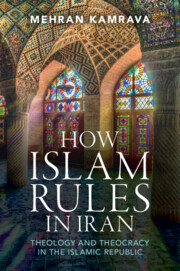Book contents
- How Islam Rules in Iran
- How Islam Rules in Iran
- Copyright page
- Contents
- Preface
- 1 Introduction
- 2 The Setting
- 3 A Question of Jurisprudence
- 4 Social Protection and Guidance
- 5 Rethinking the Islamic Republic
- 6 Theorizing Islamic Democracy
- 7 Legitimate Authority
- 8 Khameneism and the Absolute Velayat-e Faqih
- 9 Whither the Islamic Republic?
- Appendix Brief Biography of Some of the Figures Discussed
- Glossary
- Bibliography
- Index
2 - The Setting
Published online by Cambridge University Press: 02 May 2024
- How Islam Rules in Iran
- How Islam Rules in Iran
- Copyright page
- Contents
- Preface
- 1 Introduction
- 2 The Setting
- 3 A Question of Jurisprudence
- 4 Social Protection and Guidance
- 5 Rethinking the Islamic Republic
- 6 Theorizing Islamic Democracy
- 7 Legitimate Authority
- 8 Khameneism and the Absolute Velayat-e Faqih
- 9 Whither the Islamic Republic?
- Appendix Brief Biography of Some of the Figures Discussed
- Glossary
- Bibliography
- Index
Summary
As the 1978–1979 revolution approached, Khomeini’s reactionary conceptions of the ideal social order were all but forgotten. The popular assumption was that Khomeini and, along with him, the rest of the clerical establishment were “revolutionary” in the true sense of the word. But the clerical establishment, which had long been divided among itself, had engaged in little innovation of any kind, either on its own or through the institution of the howzeh. Equally valuable for the victors of the revolution has been the howzeh, a hallowed institution of religious teaching and learning for the better part of a century. For nearly as long, it has been a bastion of jurisprudential traditionalism. Khomeini saw it as archaic. Two decades later, Khamenei extended the state’s capture to the howzeh, bureaucratized it, ensured its financial dependence, and, through added administrative units, made it a practical extension of the state. If the howzeh was ever a forum for jurisprudential innovation, that rare possibility is even rarer now. Not surprisingly, what jurisprudential innovation has taken place, by Khomeini and by successive generations of religious scholars, has been overwhelmingly outside of the howzeh.
Keywords
- Type
- Chapter
- Information
- How Islam Rules in IranTheology and Theocracy in the Islamic Republic, pp. 11 - 57Publisher: Cambridge University PressPrint publication year: 2024

